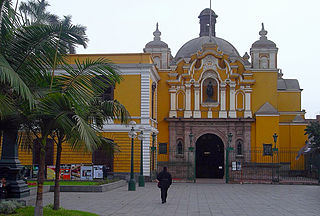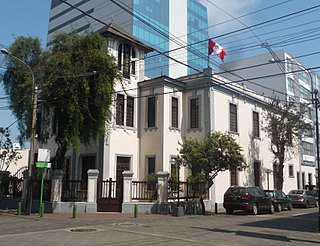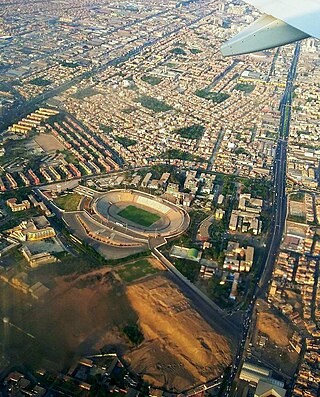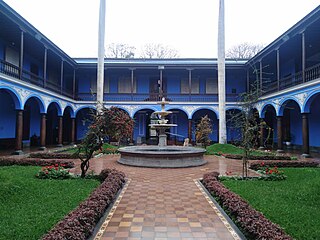
The National University of San Marcos is a public research university located in Lima, the capital of Peru. In the Americas, it is the first officially established and the oldest continuously operating university.

The Basilica Metropolitan Cathedral of Lima and Primate of Peru, otherwise Lima Metropolitan Cathedral, is a Roman Catholic cathedral located in the Plaza Mayor of downtown Lima, Peru. This third and current Cathedral of Lima was built between 1602 and 1797. It is dedicated to St. John, Apostle and Evangelist.

Barranco, founded in 1874 as San José de Surco, is one of 43 districts in Lima, Peru. Its current mayor is Jessica Vargas.

The Historic Centre of Lima is the historic city centre of the city of Lima, the capital of Peru. Located in the city's districts of Lima and Rímac, both in the Rímac Valley, it consists of two areas: the first is the Monumental Zone established by the Peruvian government in 1972, and the second one—contained within the first one—is the World Heritage Site established by UNESCO in 1988, whose buildings are marked with the organisation's black-and-white shield.

Ruth Martha Shady Solís is a Peruvian anthropologist and archaeologist. She is the founder and director of the archaeological project at Caral.

The National Museum of Archaeology, Anthropology, and History of Peru is the largest and oldest museum in Peru, housed at the Palacio de la Magdalena, located in the main square of Pueblo Libre, a district of Lima, Peru. The museum houses more than 100,000 artifacts spanning the entire history of human occupation in what is now Peru. Highlights include the Raimondi Stele and the Tello Obelisk from Chavín de Huantar, and an impressive scale model of the Incan citadel, Machu Picchu. As of 2023, the museum is under restoration and very few rooms are open for visitors.

The Natural History Museum in Lima, is Peru's most important museum of natural history. It was established in 1918 and belongs to the National University of San Marcos.

The Seminary of Saint Turibius, also known as the Seminary of Lima or, is a priestly seminary in charge of training seminarians to be future priests of the Roman Catholic Archdiocese of Lima. It is based in Lima, Peru, and is the second oldest seminary in the Americas after that of Bogotá, having been founded on December 7, 1591, by then Archbishop Turibius of Mongrovejo.

The Heroes' Pantheon is a crypt inside the old Church of San Carlos, located at the former Real Convictorio de San Carlos in the historic centre of Lima, that holds the remains of 24 of the national heroes of the Peruvian War of Independence.
The Editorial Fund of the National University of San Marcos is the publishing division of the university. It is responsible for the production and dissemination of physical and digital books and magazines that offer new knowledge for the global society. These publications constitute a key pillar in the formation and development of Peruvian humanistic and scientific traditions, and represent the firm commitment of the University of San Marcos to culture and disciplinary research.

Pedro Salvino Zulen Aymar was a Peruvian philosopher and librarian of Chinese descent, who dedicated the most part of his short life to the fight for decentralised politics and the defense of indigenous rights.

The Raúl Porras Barrenechea Institute of the National University of San Marcos (IRPB-UNMSM) was founded in 1964 by the University of San Marcos in honor of the distinguished alum, Peruvian historian and diplomat Raúl Porras Barrenechea. The institute acts as a Center for Higher Studies and Peruvian Research, developing and promoting research mainly related to the areas of humanities, arts and social sciences. To this end, the institute offers researchers and the general public a library specialized in the mentioned fields.

The University City of the National University of San Marcos, generally known as the University City of Lima or simply University City, is the main campus of the National University of San Marcos and is located in Lima District. In the University City of San Marcos are located the main administrative facilities of the university, such as the rectory. It is home to 17 of the 20 faculties of the University of San Marcos, the central library, the San Marcos University Stadium, the university gymnasium, the dining room of the "University City" and one of the university residences. In addition, the City includes the archaeological complex of the Huaca San Marcos, which is preserved and studied by San Marcos students and researchers.

Pablo Macera was a Peruvian historian.

Pedro Gálvez Egúsquiza was a Peruvian lawyer, politician, educator and diplomat. A staunch liberal, he was one of the leaders of the Liberal Revolution of 1854 headed by General Ramón Castilla. He is remembered for having been the drafter of the decree that abolished the tribute of the natives. He was Minister of Justice and Worship in 1855, and Minister of Finance and Commerce in 1862, in the second government of Ramón Castilla; President of the Council of Ministers and Minister of Government (1868–1869) in the government of José Balta; constituent deputy (1855–1857) and senator (1868–1869). Likewise, he exercised various diplomatic representations in the United States, Latin America and Europe.

University Park is a public park located in the historic centre of the city of Lima, Peru. It is rectangular in shape and is located at the intersection of Abancay and Nicolás de Piérola avenues.

The Real Convictorio de San Carlos, or Convictorio de San Carlos after independence, was a college in Lima created at the end of the Viceroyalty of Peru and which survived until the first decades of the Peruvian Republic.

Jirón Áncash is a major street in the Damero de Pizarro, located in the historic centre of Lima, Peru. The street starts at its intersection with the Jirón de la Unión at the Puente de Piedra, and continues until it reaches the Óvalo de la Paz.

The National Museum of Peruvian Culture, formerly the National Archaeology Museum, is a museum dedicated to Peruvian culture in Lima, Peru.

The Royal College of the University of San Marcos, also known by its former name of Royal College of San Felipe, is a historic building in the Barrios Altos neighbourhood of Lima, Peru. It's one of two cultural centres operated by the University of San Marcos.





























